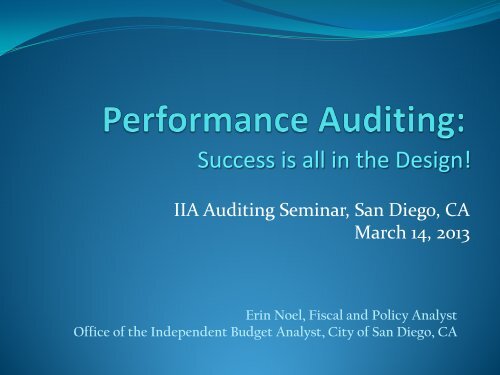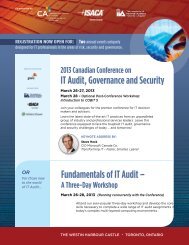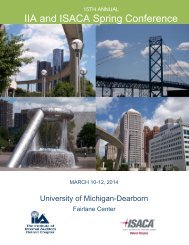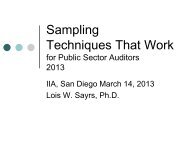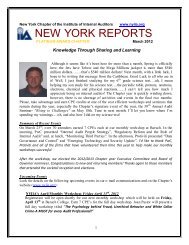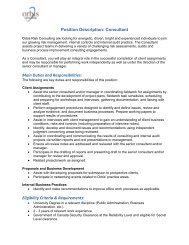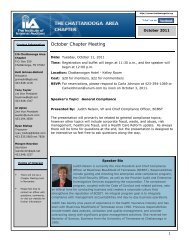Performance Auditing Success is All in the Design - Chapters Site
Performance Auditing Success is All in the Design - Chapters Site
Performance Auditing Success is All in the Design - Chapters Site
You also want an ePaper? Increase the reach of your titles
YUMPU automatically turns print PDFs into web optimized ePapers that Google loves.
<strong>Success</strong> <strong>is</strong> all <strong>in</strong> <strong>the</strong> <strong>Design</strong>!<br />
IIA <strong>Audit<strong>in</strong>g</strong> Sem<strong>in</strong>ar, San Diego, CA<br />
March 14, 2013<br />
Er<strong>in</strong> Noel, F<strong>is</strong>cal and Policy Analyst<br />
Office of <strong>the</strong> Independent Budget Analyst, City of San Diego, CA
Introductions -<br />
My Background and Perspective -<br />
• GAO <strong>Performance</strong> <strong>Audit<strong>in</strong>g</strong><br />
• Office of <strong>the</strong> City Auditor<br />
• Role at IBA<br />
Gett<strong>in</strong>g to Know You -<br />
• Background, organizations<br />
• Types of audit<strong>in</strong>g<br />
• Goals<br />
2
Session Agenda -<br />
• <strong>Performance</strong> <strong>Audit<strong>in</strong>g</strong> Basics<br />
• Audit Plann<strong>in</strong>g<br />
• The Hook<br />
• Criteria<br />
• Deconstruct<strong>in</strong>g <strong>the</strong> Issue<br />
• Intro to <strong>the</strong> <strong>Design</strong> Matrix (DM)<br />
• What <strong>is</strong> it anyway?<br />
• DM Attachment - <strong>Performance</strong> Audit Tool<br />
• Develop<strong>in</strong>g <strong>the</strong> DM<br />
• L<strong>in</strong>kages<br />
• <strong>Design</strong> Summit<br />
• Key Takeaways<br />
3
<strong>Performance</strong> <strong>Audit<strong>in</strong>g</strong> Basics -<br />
M<strong>is</strong>sion -<br />
• To help improve <strong>the</strong> performance and ensure <strong>the</strong><br />
accountability of <strong>the</strong> government for <strong>the</strong><br />
benefit of citizens.<br />
• To exam<strong>in</strong>e how taxpayer dollars are spent and<br />
adv<strong>is</strong>e dec<strong>is</strong>ion makers on ways to make<br />
government more efficient, effective, ethical,<br />
equitable, and responsive.<br />
Our work leads to improvements <strong>in</strong> operations and<br />
saves <strong>the</strong> government and taxpayers valuable<br />
resources, money, and time.<br />
4
<strong>Performance</strong> <strong>Audit<strong>in</strong>g</strong> Basics -<br />
Objectives -<br />
• <strong>Audit<strong>in</strong>g</strong> agency operations to determ<strong>in</strong>e whe<strong>the</strong>r<br />
government funds are be<strong>in</strong>g spent efficiently and<br />
effectively.<br />
• Investigat<strong>in</strong>g allegations of illegal and improper<br />
activities.<br />
• Report<strong>in</strong>g on how well government programs and<br />
policies are meet<strong>in</strong>g <strong>the</strong>ir objectives.<br />
• Perform<strong>in</strong>g analyses and, where appropriate, mak<strong>in</strong>g<br />
recommendations for improvement.<br />
F<strong>in</strong>d<strong>in</strong>gs may <strong>in</strong>volve deficiencies <strong>in</strong> <strong>in</strong>ternal control;<br />
noncompliance with prov<strong>is</strong>ions, of laws, regulations,<br />
contracts, or agreements; fraud; waste; or abuse.<br />
5
<strong>Performance</strong> <strong>Audit<strong>in</strong>g</strong> Basics -<br />
The Elements of a F<strong>in</strong>d<strong>in</strong>g -<br />
• To comply with GAGAS, auditors should<br />
plan and perform procedures to develop<br />
<strong>the</strong> elements of <strong>the</strong> f<strong>in</strong>d<strong>in</strong>gs that are<br />
relevant and necessary to achieve <strong>the</strong><br />
audit objectives.<br />
Criteria<br />
Condition<br />
Cause<br />
Effect<br />
Us<strong>in</strong>g all four elements—criteria, condition, cause, and<br />
effect—will enable you to construct a conv<strong>in</strong>c<strong>in</strong>g<br />
argument for why an agency should act on your<br />
recommendations.<br />
6
<strong>Performance</strong> <strong>Audit<strong>in</strong>g</strong> Basics -<br />
The Elements of a F<strong>in</strong>d<strong>in</strong>g –<br />
• Criteria are standards for <strong>the</strong> desired state aga<strong>in</strong>st which<br />
performance <strong>is</strong> evaluated. Provide context for evaluat<strong>in</strong>g<br />
evidence and understand<strong>in</strong>g <strong>the</strong> f<strong>in</strong>d<strong>in</strong>gs.<br />
• Condition describes <strong>the</strong> situation that ex<strong>is</strong>ts and refers to<br />
<strong>the</strong> program character<strong>is</strong>tics or results your team found.<br />
• Cause expla<strong>in</strong>s why <strong>the</strong> condition differs from <strong>the</strong> criteria.<br />
• Effect <strong>is</strong> <strong>the</strong> “so what” of <strong>the</strong> condition and describes <strong>the</strong><br />
actual or potential impact or consequences of a condition<br />
that differs from <strong>the</strong> criteria.<br />
Recommendations must be designed to address <strong>the</strong> root<br />
cause of <strong>the</strong> problem you identify.<br />
7
<strong>Performance</strong> <strong>Audit<strong>in</strong>g</strong> Basics -<br />
<strong>Performance</strong> Audits generally have four phases.<br />
Phase 1<br />
Plann<strong>in</strong>g/<strong>Design</strong><br />
Phase 2<br />
Fieldwork<br />
Phase 3<br />
Report<br />
Development<br />
Phase 4<br />
Follow Up<br />
‣While we are go<strong>in</strong>g to be focus<strong>in</strong>g on <strong>the</strong><br />
plann<strong>in</strong>g phase, it <strong>is</strong> important to consider<br />
<strong>the</strong> subsequent stages…<br />
8
<strong>Performance</strong> <strong>Audit<strong>in</strong>g</strong> Basics -<br />
It <strong>is</strong> important to understand audit outputs and<br />
l<strong>in</strong>kages…<br />
Phase 1<br />
Plann<strong>in</strong>g<br />
Phase 2<br />
Fieldwork<br />
Phase 3<br />
Report<br />
Development<br />
Phase 4<br />
Follow Up<br />
Audit Program/<br />
<strong>Design</strong> Matrix<br />
<strong>Design</strong> Matrix<br />
Attachment<br />
Audit Budget<br />
F<strong>in</strong>d<strong>in</strong>gs/<br />
Message<br />
Development<br />
(C3E)<br />
Report<br />
Brief<strong>in</strong>gs<br />
Accompl<strong>is</strong>hment<br />
Report<br />
Update Report<br />
…because your audit plan will be <strong>the</strong> guide for<br />
fieldwork and <strong>the</strong> bas<strong>is</strong> for development of f<strong>in</strong>d<strong>in</strong>gs<br />
and report writ<strong>in</strong>g.<br />
9
Fail<strong>in</strong>g to plan…<strong>is</strong> plann<strong>in</strong>g to fail.<br />
10
Audit Plann<strong>in</strong>g -<br />
Objectives -<br />
• Perform an educated overview of a policy, program,<br />
function, or organization to determ<strong>in</strong>e which<br />
specific <strong>is</strong>sues warrant more <strong>in</strong>-depth analys<strong>is</strong>.<br />
• Develop an effective approach and methodology for<br />
conduct<strong>in</strong>g <strong>the</strong> more <strong>in</strong>-depth analys<strong>is</strong> dur<strong>in</strong>g <strong>the</strong><br />
fieldwork phase.<br />
• Determ<strong>in</strong>e <strong>the</strong> relative importance of <strong>the</strong> audit so we<br />
can effectively:<br />
‣assign audit resources<br />
‣establ<strong>is</strong>h a schedule<br />
11
Audit Plann<strong>in</strong>g -<br />
Goals for Plann<strong>in</strong>g/<strong>Design</strong> -<br />
• Fully understand<strong>in</strong>g background and context of<br />
<strong>is</strong>sue<br />
• Identify<strong>in</strong>g solid criteria<br />
• Develop<strong>in</strong>g a methodology that will get to heart of<br />
<strong>is</strong>sues<br />
• Identify<strong>in</strong>g and plann<strong>in</strong>g to address limitations<br />
Well-planned audits generally will have shorter field<br />
work and report writ<strong>in</strong>g stages because you have done<br />
<strong>the</strong> heavy lift<strong>in</strong>g up front.<br />
12
Audit Plann<strong>in</strong>g -<br />
The timeframe for plann<strong>in</strong>g<br />
depends on several factors, such<br />
as <strong>the</strong>:<br />
• complexity of <strong>is</strong>sue(s)<br />
• importance of <strong>is</strong>sue(s)<br />
• available resources<br />
• compet<strong>in</strong>g audit priorities<br />
• time-criticality<br />
<strong>Design</strong><br />
Fieldwork<br />
Report Writ<strong>in</strong>g<br />
General rule of thumb <strong>is</strong> about a<br />
third of audit.<br />
13
Audit Plann<strong>in</strong>g - Adm<strong>in</strong>strivia<br />
• Initiat<strong>in</strong>g audit and assign<strong>in</strong>g staff<br />
• Conduct<strong>in</strong>g prelim research<br />
• Meet<strong>in</strong>g with audit managers to<br />
understand <strong>the</strong> context of <strong>the</strong> audit<br />
• Notify<strong>in</strong>g appropriate department<br />
officials<br />
• Request<strong>in</strong>g prelim<strong>in</strong>ary data and<br />
documents<br />
• Meet<strong>in</strong>g with key department<br />
officials<br />
14
Audit Plann<strong>in</strong>g - Where to start?<br />
•The Hook - understand<strong>in</strong>g<br />
<strong>the</strong> context of <strong>the</strong> <strong>is</strong>sue.<br />
•Research<strong>in</strong>g criteria,<br />
<strong>in</strong>clud<strong>in</strong>g recommended<br />
practices.<br />
•Deconstruct<strong>in</strong>g <strong>the</strong> City’s<br />
CIP.<br />
Identify<strong>in</strong>g your approach.<br />
15
Example – CIP Audit<br />
The Hook - Key Macro Issues<br />
A well designed and<br />
ma<strong>in</strong>ta<strong>in</strong>ed<br />
<strong>in</strong>frastructure<br />
anchors our economy<br />
and secures <strong>the</strong><br />
public health and<br />
well be<strong>in</strong>g.<br />
Investment <strong>in</strong><br />
<strong>in</strong>frastructure <strong>is</strong> vital<br />
to productivity,<br />
competitiveness, and<br />
<strong>the</strong> economy.<br />
1. Infrastructure <strong>in</strong> <strong>the</strong> United<br />
States and Canada <strong>is</strong> primarily<br />
owned and operated by state<br />
and local governments.<br />
2. Investment at all levels has not<br />
kept pace with grow<strong>in</strong>g<br />
demands and regulatory<br />
requirements, result<strong>in</strong>g <strong>in</strong>:<br />
• deferred ma<strong>in</strong>tenance,<br />
• deteriorat<strong>in</strong>g <strong>in</strong>frastructure,<br />
• decreased performance and<br />
reliability, and<br />
• a r<strong>is</strong>k to public health and safety.<br />
16
Example – CIP Audit<br />
The Hook - Key Micro Issues<br />
San Diego’s economy <strong>is</strong> <strong>in</strong>extricably l<strong>in</strong>ked to <strong>the</strong><br />
convention and tour<strong>is</strong>m <strong>in</strong>dustries which are impacted by<br />
<strong>the</strong> quality, condition, appearance and cont<strong>in</strong>uity of<br />
operation of <strong>in</strong>frastructure assets.<br />
The City has faced long-term f<strong>in</strong>ancial challenges:<br />
California’s Prop 13 - Tax <strong>in</strong>creases requires 2/3 voter approval<br />
Sordid past f<strong>in</strong>ancial practices - Underfund<strong>in</strong>g pension fund to<br />
pay for new baseball stadium…m<strong>is</strong>s<strong>in</strong>g f<strong>in</strong>ancial statements<br />
Suspended credit rat<strong>in</strong>g - Limited access to public bond<br />
markets (2004-2008)<br />
Structural budget deficit (FY 2003-2011) - Large cuts without<br />
transparency over full impact<br />
17
Criteria -<br />
Identify<strong>in</strong>g<br />
criteria up front<br />
will provide a<br />
comprehensive<br />
start<strong>in</strong>g po<strong>in</strong>t to<br />
drive your<br />
questions and<br />
prevent holes that<br />
you m<strong>is</strong>s or have<br />
to fill <strong>in</strong> later,<br />
ra<strong>the</strong>r than just<br />
f<strong>is</strong>h<strong>in</strong>g.<br />
• Leg<strong>is</strong>lation, regulations,<br />
codes, and mandates<br />
• Department policies,<br />
adm<strong>in</strong><strong>is</strong>trative<br />
regulations, guidance,<br />
manuals<br />
• Industry standards,<br />
guidance, and best<br />
practices<br />
• Databases, City systems<br />
• O<strong>the</strong>r cities’ practices<br />
18
Public Utilities CIP Audit<br />
Criteria -<br />
Example:<br />
Components<br />
of Asset<br />
Management<br />
Goals and Objectives<br />
Asset Inventory<br />
Condition Assessment and<br />
Investment Needs Model<strong>in</strong>g<br />
Alternatives Evaluation and<br />
Program Optimization<br />
Short- and Long-Range Plans<br />
(Project Selection)<br />
Budget /<br />
<strong>All</strong>ocations<br />
Program Implementation<br />
<strong>Performance</strong> Monitor<strong>in</strong>g<br />
19
Example – CIP Audit<br />
Deconstruct<strong>in</strong>g <strong>the</strong> Program -<br />
• Review<strong>in</strong>g City<br />
policies,<br />
regulations, etc.<br />
• Review<strong>in</strong>g<br />
department<br />
procedures<br />
• Interview<strong>in</strong>g<br />
officials<br />
‣ Diagramm<strong>in</strong>g<br />
processes<br />
20
Example – CIP Audit<br />
The Approach -<br />
Deconstruct<strong>in</strong>g <strong>the</strong><br />
City’s CIP<br />
• Collect<strong>in</strong>g and<br />
analyz<strong>in</strong>g budgetary<br />
and o<strong>the</strong>r data.<br />
• Interview<strong>in</strong>g more<br />
officials<br />
• Still more<br />
diagramm<strong>in</strong>g<br />
As <strong>the</strong> audit team began to understand<br />
<strong>the</strong> CIP, we realized:<br />
• Infrastructure and <strong>the</strong> CIP are significant<br />
<strong>is</strong>sues for <strong>the</strong> City.<br />
• The CIP process <strong>is</strong> very complicated.<br />
• There are numerous opportunities for<br />
improv<strong>in</strong>g various aspects of <strong>the</strong> CIP<br />
process.<br />
Dur<strong>in</strong>g <strong>Design</strong>, we developed a proposal<br />
for a planned body of work to <strong>in</strong>clude<br />
3 audits:<br />
• CIP 1 - Overview of <strong>the</strong> CIP<br />
• CIP 2 - Public Works Contract<strong>in</strong>g<br />
• CIP 3 - Construction Management<br />
21
Example – CIP Audit<br />
<strong>Design</strong> Matrix -<br />
• We developed high-level design matrices for CIP 2 and 3,<br />
but developed an <strong>in</strong>-depth Matrix for CIP 1.<br />
• Th<strong>is</strong> was <strong>in</strong>valuable, because it helped us:<br />
• Th<strong>in</strong>k forward to set up f<strong>in</strong>d<strong>in</strong>gs development/C3E and<br />
report message and recommendations.<br />
• Thoroughly consider questions and how plan to answer<br />
• Identify potential limitations and consider how to overcome<br />
• Consider <strong>the</strong> significance of what we would be able to say<br />
Researchable<br />
Questions<br />
R<strong>is</strong>k(s)<br />
Scope and<br />
Methodology<br />
Information<br />
Required and<br />
Source(s)<br />
Limitations<br />
What will I be<br />
able to say?<br />
Q1:<br />
Q2:<br />
Q3:<br />
22
The <strong>Design</strong> Matrix-<br />
Researchable<br />
Questions<br />
R<strong>is</strong>k(s)<br />
Scope and<br />
Methodology<br />
Information<br />
Required and<br />
Source(s)<br />
Limitations<br />
What will I be<br />
able to say?<br />
Q1: To what<br />
extent…<br />
Evaluative<br />
Q2: How… Evaluative<br />
Q3: What.. Fact Based<br />
‣It <strong>is</strong> important to know what your<br />
goal/output <strong>is</strong> for plann<strong>in</strong>g so you can<br />
decide how to get <strong>the</strong>re.<br />
23
The <strong>Design</strong> Matrix- <strong>Performance</strong> Audit Tool<br />
• The purpose of <strong>the</strong> tool <strong>is</strong> to ass<strong>is</strong>t audit teams<br />
dur<strong>in</strong>g plann<strong>in</strong>g to determ<strong>in</strong>e whe<strong>the</strong>r <strong>the</strong><br />
follow<strong>in</strong>g are significant to audit objectives:<br />
• <strong>in</strong>ternal controls,<br />
• compliance with laws and regulations,<br />
• fraud r<strong>is</strong>k and/or o<strong>the</strong>r potential abuse are<br />
• Th<strong>is</strong> tool also helps to document that you have<br />
considered <strong>the</strong>se important factors.<br />
24
The <strong>Design</strong> Matrix- <strong>Performance</strong> Audit Tool<br />
A.1 <strong>Design</strong> and implementation of<br />
<strong>in</strong>ternal controls (GAS 7.11b, 7.16)<br />
Yes No N/A WP Reference or<br />
Auditor’s Note As<br />
Appropriate<br />
Did <strong>the</strong> Department design and<br />
implement policies and procedures for<br />
manag<strong>in</strong>g <strong>the</strong> program?<br />
A.2 <strong>Design</strong> and implementation of<br />
<strong>in</strong>formation system <strong>in</strong>ternal controls<br />
(GAS 7.11c,7.24-7.27)<br />
B. Potential for fraud and abuse (GAS<br />
7.11d, 7.30)<br />
C. Legal and regulatory requirements,<br />
contract prov<strong>is</strong>ions (GAS 7.11d, 7.28)<br />
x<br />
Interview with Street<br />
Div<strong>is</strong>ion Deputy<br />
Director<br />
D. Consideration of <strong>the</strong> nature of <strong>the</strong><br />
program and needs of potential users<br />
(GAS 7.11a, 7.13)<br />
E. Results of Previous Audits (GAS<br />
7.11e, 7.36)<br />
25
The <strong>Design</strong> Matrix- Development<br />
• Researchable questions and sub-questions can be<br />
evaluative or descriptive, depend<strong>in</strong>g on what we<br />
hope to f<strong>in</strong>d out.<br />
• These are generally based on r<strong>is</strong>k.<br />
Researchable<br />
Questions<br />
R<strong>is</strong>k(s)<br />
Scope and<br />
Methodology<br />
Information<br />
Required and<br />
Source(s)<br />
Limitations<br />
What will I be<br />
able to say?<br />
Q1: To what<br />
extent…<br />
Evaluative<br />
Q2: What.. Fact Based<br />
26
Street Ma<strong>in</strong>tenance Audit<br />
The <strong>Design</strong> Matrix- Development<br />
Researchable Questions<br />
Q1: To what extent do City departments coord<strong>in</strong>ate work on or<br />
under City streets?<br />
1(a) How does <strong>the</strong> Street Div<strong>is</strong>ion plan, communicate, and coord<strong>in</strong>ate<br />
resurfac<strong>in</strong>g projects with o<strong>the</strong>r departments and private entities?<br />
1(b) To what extent are City departments and private entities required to<br />
obta<strong>in</strong> permits for street excavations?<br />
1(c) To what extent do City departments monitor and enforce permit<br />
and/or trench cut moratorium requirements?<br />
1(d) What <strong>is</strong> <strong>the</strong> status of <strong>the</strong> City’s planned GIS system for identify<strong>in</strong>g<br />
project conflicts, and how will th<strong>is</strong> help prevent trench cuts <strong>in</strong>to newly<br />
resurfaced streets?<br />
27
Street Ma<strong>in</strong>tenance Audit<br />
The <strong>Design</strong> Matrix- Development<br />
Researchable<br />
Questions<br />
Q1: To what<br />
extent do City<br />
departments<br />
coord<strong>in</strong>ate<br />
work on or<br />
under City<br />
streets?<br />
R<strong>is</strong>k(s)<br />
Without formalized requirements and processes to plan,<br />
communicate, and coord<strong>in</strong>ate activity, <strong>the</strong>re <strong>is</strong> <strong>the</strong> r<strong>is</strong>k that<br />
departments and private entities will excavate <strong>in</strong>to a street multiple<br />
times which <strong>in</strong>creases <strong>the</strong> cost for <strong>the</strong> City and causes <strong>the</strong> street<br />
condition to degrade at a faster rate.<br />
If City Departments are not enforc<strong>in</strong>g permit requirements for<br />
private entities excavation of streets, taxpayers will have to<br />
subsidize street ma<strong>in</strong>tenance and repairs.<br />
28
The <strong>Design</strong> Matrix- Development<br />
• Scope – What are <strong>the</strong> parameters of <strong>the</strong> audit?<br />
• Methodology based on C3E:<br />
• How will you answer researchable questions?<br />
• How will you identify <strong>the</strong> criteria, condition, cause, and effect?<br />
Researchable<br />
Questions<br />
R<strong>is</strong>k(s)<br />
Scope and<br />
Methodology<br />
Information<br />
Required and<br />
Source(s)<br />
Limitations<br />
What will I be<br />
able to say?<br />
Q1:<br />
Q2:<br />
Q3:<br />
29
Street Ma<strong>in</strong>tenance Audit<br />
The <strong>Design</strong> Matrix- Development<br />
Researchable<br />
Questions<br />
Q1: To what<br />
extent do City<br />
departments<br />
coord<strong>in</strong>ate<br />
work on or<br />
under City<br />
streets?<br />
Scope and Methodology<br />
Scope: Inter-departmental and <strong>in</strong>ter-organizational coord<strong>in</strong>ation<br />
<strong>is</strong>sues related to <strong>the</strong> City’s street ma<strong>in</strong>tenance over <strong>the</strong> past 5 years.<br />
Th<strong>is</strong> <strong>in</strong>cludes resurfac<strong>in</strong>g (asphalt overlay and slurry seal) for<br />
ma<strong>in</strong>tenance or emergency repairs, but excludes pothole repairs.<br />
________________________________<br />
Methodology:<br />
Criteria<br />
1. Municipal Code relat<strong>in</strong>g to <strong>the</strong> trench cut moratorium for<br />
newly resurfaced street<br />
2. Street Div<strong>is</strong>ion’s and Eng<strong>in</strong>eer<strong>in</strong>g Department’s policies and<br />
procedures for coord<strong>in</strong>at<strong>in</strong>g project conflicts<br />
3. Review literature and <strong>in</strong>terview officials from o<strong>the</strong>r cities to<br />
identify best/recommended practices for <strong>in</strong>ter-departmental<br />
coord<strong>in</strong>ation of street work.<br />
30
Street Ma<strong>in</strong>tenance Audit<br />
The <strong>Design</strong> Matrix- Development<br />
Researchable<br />
Questions<br />
Q1: To what<br />
extent do City<br />
departments<br />
coord<strong>in</strong>ate<br />
work on or<br />
under City<br />
streets?<br />
Scope and Methodology<br />
Methodology (Cont<strong>in</strong>ued):<br />
Condition<br />
1. Conduct a sample of streets, <strong>in</strong>clud<strong>in</strong>g site assessments and<br />
photographs of street conditions, to determ<strong>in</strong>e <strong>the</strong> extent to which<br />
trench cuts are be<strong>in</strong>g made <strong>in</strong>to newly resurfaced streets.<br />
Cause<br />
1. Interview City department staff responsible for coord<strong>in</strong>ation of<br />
work and identification of project conflicts.<br />
2. Trace newly resurfaced streets <strong>in</strong> sample to permits to determ<strong>in</strong>e<br />
reasons for trench cut, such as emergency repairs.<br />
Effect<br />
1. Review <strong>in</strong>dustry <strong>in</strong>formation on impacts of trench cuts and public<br />
compla<strong>in</strong>ts received by Council Members and/or City departments.<br />
31
The <strong>Design</strong> Matrix- Development<br />
• What <strong>in</strong>formation and data <strong>is</strong> needed for<br />
methodology?<br />
• What are ex<strong>is</strong>t<strong>in</strong>g or potential limitations, and how<br />
would you mitigate <strong>the</strong>se?<br />
Researchable<br />
Questions<br />
R<strong>is</strong>k(s)<br />
Scope and<br />
Methodology<br />
Information<br />
Required and<br />
Source(s)<br />
Limitations/<br />
Mitigation<br />
Plan<br />
What will I be<br />
able to say?<br />
Q1:<br />
Q2:<br />
Q3:<br />
32
Street Ma<strong>in</strong>tenance Audit<br />
The <strong>Design</strong> Matrix- Development<br />
Researchable<br />
Questions<br />
Q1: To what<br />
extent do City<br />
departments<br />
coord<strong>in</strong>ate<br />
work on or<br />
under City<br />
streets?<br />
Information Required and<br />
Source(s)<br />
Documents and Data:<br />
•Municipal Code for street<br />
excavations<br />
•Street resurfac<strong>in</strong>g contracts<br />
•Records of excavation permits<br />
Sources:<br />
• Streets Div<strong>is</strong>ion and<br />
Eng<strong>in</strong>eer<strong>in</strong>g Department<br />
officials<br />
•Street Div<strong>is</strong>ions Pavement<br />
Management System<br />
•Development Services<br />
Department Permit Track<strong>in</strong>g<br />
System<br />
Limitations and Mitigation Plan<br />
Limitation:<br />
Based on our first street<br />
ma<strong>in</strong>tenance audit, we know that<br />
Street Div<strong>is</strong>ion’s Pavement<br />
Management System conta<strong>in</strong>s street<br />
condition <strong>in</strong>formation that <strong>is</strong> out of<br />
date.<br />
Mitigation Plan:<br />
We will pull our street sample from<br />
recent resurfac<strong>in</strong>g contracts and<br />
make site v<strong>is</strong>its and take<br />
photographs to ensure <strong>the</strong> accuracy<br />
of <strong>in</strong>formation for our sample.<br />
33
The <strong>Design</strong> Matrix- Development<br />
• Fully th<strong>in</strong>k<strong>in</strong>g through what you will be able to say<br />
based on <strong>the</strong> methodology forces you to th<strong>in</strong>k<br />
forward.<br />
‣Determ<strong>in</strong>e significance of audit so can assess use of<br />
resources and time relative to o<strong>the</strong>r audits.<br />
Researchable<br />
Questions<br />
R<strong>is</strong>k(s)<br />
Scope and<br />
Methodology<br />
Information<br />
Required and<br />
Source(s)<br />
Limitations<br />
What will I be<br />
able to say?<br />
Q1:<br />
Q2:<br />
Q3:<br />
34
Street Ma<strong>in</strong>tenance Audit<br />
The <strong>Design</strong> Matrix- Development<br />
Researchable<br />
Questions<br />
Q1: To what extent do<br />
City departments<br />
coord<strong>in</strong>ate work on or<br />
under City streets?<br />
What will I be able to say?<br />
We expect to f<strong>in</strong>d that coord<strong>in</strong>ation of work<br />
performed on or under City streets <strong>is</strong> limited.<br />
We may be able to recommend that <strong>the</strong> Public<br />
Works Director develop a Citywide excavation<br />
plan for all planned ma<strong>in</strong>tenance work and<br />
share th<strong>is</strong> with all departments and private<br />
entities that conduct work on or under City<br />
streets.<br />
35
<strong>Performance</strong> <strong>Audit<strong>in</strong>g</strong> Basics -<br />
It <strong>is</strong> important to understand audit outputs and<br />
l<strong>in</strong>kages…<br />
Phase 1<br />
Plann<strong>in</strong>g<br />
Phase 2<br />
Fieldwork<br />
Phase 3<br />
Report<br />
Development<br />
Phase 4<br />
Follow Up<br />
Audit Program/<br />
<strong>Design</strong> Matrix<br />
<strong>Design</strong> Matrix<br />
Attachment<br />
Audit Budget<br />
F<strong>in</strong>d<strong>in</strong>gs/<br />
Message<br />
Development<br />
(C3E)<br />
Report<br />
Brief<strong>in</strong>gs<br />
Accompl<strong>is</strong>hment<br />
Report<br />
Update Report<br />
…because your audit plan will be <strong>the</strong> guide for<br />
fieldwork and <strong>the</strong> bas<strong>is</strong> for development of f<strong>in</strong>d<strong>in</strong>gs<br />
and report writ<strong>in</strong>g.<br />
36
Street Ma<strong>in</strong>tenance Audit<br />
L<strong>in</strong>kages-<br />
<strong>Design</strong> Matrix<br />
F<strong>in</strong>d<strong>in</strong>gs Development<br />
Researchable<br />
Questions<br />
Q1: To what<br />
extent do City<br />
departments<br />
coord<strong>in</strong>ate<br />
work on or<br />
under City<br />
streets?<br />
Scope and Methodology<br />
Criteria<br />
Municipal Code relat<strong>in</strong>g<br />
to <strong>the</strong> trench cut<br />
moratorium…<br />
Condition<br />
Conduct a sample of<br />
streets…<br />
Cause<br />
Interview officials and<br />
assess conflict<br />
management<br />
system…<br />
Effect<br />
Review <strong>in</strong>dustry<br />
<strong>in</strong>formation on<br />
impact of trench<br />
cuts…<br />
F<strong>in</strong>d<strong>in</strong>g<br />
Coord<strong>in</strong>ation<br />
and plann<strong>in</strong>g<br />
of streetsrelated<br />
work<br />
<strong>is</strong> limited.<br />
C3E<br />
Criteria: Municipal Code has a<br />
moratorium on excavations <strong>in</strong>to<br />
resurfaced streets for 3 years…<br />
Condition: 18% of streets resurfaced<br />
dur<strong>in</strong>g FY 2009 were excavated<br />
dur<strong>in</strong>g moratorium…<br />
Cause: City departments are not<br />
required to plan citywide excavation<br />
work and <strong>the</strong> GIS system for<br />
manag<strong>in</strong>g project conflicts has<br />
limitations…<br />
Effect: Cont<strong>in</strong>ued excavations <strong>in</strong>to<br />
newly resurfaced streets degrade<br />
pavement conditions, <strong>in</strong>crease<br />
lifecycle costs, and reduce <strong>the</strong> City’s<br />
ability to leverage resources…<br />
37
Street Ma<strong>in</strong>tenance Audit<br />
L<strong>in</strong>kages-<br />
F<strong>in</strong>d<strong>in</strong>gs Development<br />
Audit Report<br />
F<strong>in</strong>d<strong>in</strong>g<br />
Coord<strong>in</strong>ation<br />
and plann<strong>in</strong>g<br />
of streetsrelated<br />
work<br />
<strong>is</strong> limited.<br />
C3E<br />
Criteria: Municipal Code has a<br />
moratorium on excavations <strong>in</strong>to<br />
resurfaced streets for 3 years…<br />
Condition: 18% of streets resurfaced<br />
dur<strong>in</strong>g FY 2009 were excavated<br />
dur<strong>in</strong>g moratorium…<br />
Cause: City departments are not<br />
required to plan citywide excavation<br />
work and <strong>the</strong> GIS system for<br />
manag<strong>in</strong>g project conflicts has<br />
limitations…<br />
Effect: Cont<strong>in</strong>ued excavations <strong>in</strong>to<br />
newly resurfaced streets degrade<br />
pavement conditions, <strong>in</strong>crease<br />
lifecycle costs, and reduce <strong>the</strong> City’s<br />
ability to leverage resources…<br />
Coord<strong>in</strong>ation and Plann<strong>in</strong>g of Streetrelated<br />
Work Is Limited<br />
Plann<strong>in</strong>g and coord<strong>in</strong>ation of all work on<br />
or under City streets <strong>is</strong> critical to limit<br />
excavations which will degrade and<br />
shorten pavement life. Municipal Code<br />
prohibits excavations <strong>in</strong>to streets that<br />
have received asphalt overlay or slurry seal<br />
for five years and three years, respectively.<br />
We found that about 18 percent of our<br />
sample of 40 streets that were resurfaced<br />
<strong>in</strong> f<strong>is</strong>cal year 2009 were excavated dur<strong>in</strong>g<br />
<strong>the</strong> moratorium period. These excavations<br />
occurred because City departments are not<br />
required to plan Citywide excavation<br />
work. Without improved plann<strong>in</strong>g and<br />
coord<strong>in</strong>ation, excavations will degrade<br />
pavement…<br />
38
<strong>Design</strong> Summit-<br />
•Present Matrix and <strong>Performance</strong> Audit Tool<br />
•Obta<strong>in</strong> <strong>in</strong>put and make adjustments as<br />
needed<br />
•Signifies management approval of approach<br />
• Based on agreed upon plan d<strong>is</strong>cuss:<br />
• Resources needed to conduct rest of <strong>the</strong><br />
audit<br />
• Tim<strong>in</strong>g and schedule<br />
• Special access/data<br />
39
Key Takeaways-<br />
‣Effective plann<strong>in</strong>g will help to ensure a quality<br />
audit, effectively focus limited resources on key<br />
<strong>is</strong>sues and r<strong>is</strong>ks, and ensure that your<br />
methodology will get to heart of <strong>is</strong>sues.<br />
‣Identify<strong>in</strong>g criteria up front will provide a<br />
comprehensive start<strong>in</strong>g po<strong>in</strong>t to drive your<br />
questions and prevent holes that you m<strong>is</strong>s or<br />
have to fill <strong>in</strong> later.<br />
40
Key Takeaways-<br />
‣The <strong>Design</strong> Matrix <strong>is</strong> a good tool for audit<br />
plann<strong>in</strong>g because it will help you to:<br />
• Th<strong>in</strong>k forward to set up f<strong>in</strong>d<strong>in</strong>gs development/C3E<br />
and report message.<br />
• Thoroughly consider questions and how you will<br />
answer <strong>the</strong>m, <strong>in</strong>clud<strong>in</strong>g identify<strong>in</strong>g potential<br />
limitations and how you will address as well as<br />
consider<strong>in</strong>g <strong>the</strong> significance of what you will be able<br />
to say.<br />
41
Questions -<br />
ERIN NOEL,<br />
FISCAL AND POLICY ANALYST<br />
OFFICE OF THE IBA<br />
CITY OF SAN DIEGO, CA<br />
ENOEL@SANDIEGO.GOV<br />
619-236-6443<br />
42
Prepared by:<br />
Date Prepared:<br />
Reviewed by:<br />
Index:<br />
Job Code:<br />
<strong>Design</strong> Matrix for Review of Street Resurfac<strong>in</strong>g<br />
Audit Team:<br />
Problem Statement: (Provide context for <strong>the</strong> problem, for example…)<br />
A safe, reliable, and efficient driv<strong>in</strong>g environment are important for ma<strong>in</strong>ta<strong>in</strong><strong>in</strong>g our economy and<br />
quality of life. Transportation <strong>in</strong>frastructure affects commerce, commut<strong>in</strong>g, travel, and cr<strong>is</strong>es<br />
response. Years of under<strong>in</strong>vestment have resulted <strong>in</strong> deferred ma<strong>in</strong>tenance and deteriorat<strong>in</strong>g<br />
<strong>in</strong>frastructure. Based on a condition assessment of streets completed <strong>in</strong> November 2011, <strong>the</strong> City of<br />
San Diego has a deferred capital backlog of $478 million for streets. Given tight f<strong>in</strong>ancial constra<strong>in</strong>ts<br />
and compet<strong>in</strong>g priorities, <strong>the</strong> Transportation Department must make <strong>the</strong> best use of limited resources.<br />
When ride quality and structural conditions of streets degrade to fair or poor condition, costly<br />
rehabilitation <strong>is</strong> necessary to repair structural damage and restore pavement condition. Pavement<br />
preservation <strong>in</strong>cludes a planned strategy for apply<strong>in</strong>g cost-effective resurfac<strong>in</strong>g treatments to prevent<br />
<strong>the</strong> street from fail<strong>in</strong>g. The Transportation Department’s Pavement Management System <strong>in</strong>cludes<br />
asphalt overlays and slurry seal treatments. However, a number of City departments and private<br />
companies conduct work on and under City streets.<br />
August 2012 Page 1 of 2
Prepared by: Index:<br />
Date Prepared: Job Code:<br />
Reviewed by:<br />
Researchable<br />
Question(s)<br />
R<strong>is</strong>ks<br />
(Negative<br />
Effect)<br />
Information<br />
Required and<br />
Source(s)<br />
Scope and Methodology<br />
Limitations to<br />
Conduct<strong>in</strong>g<br />
Audit Work<br />
What Th<strong>is</strong> Analys<strong>is</strong><br />
Will Likely <strong>All</strong>ow Us<br />
to Say<br />
Question 1: How<br />
does <strong>the</strong><br />
Department<br />
ma<strong>in</strong>ta<strong>in</strong> <strong>the</strong><br />
<strong>in</strong>tegrity of newly<br />
resurfaced streets?<br />
1(a) To what extent<br />
does <strong>the</strong><br />
Transportation<br />
Department plan,<br />
communicate, and<br />
coord<strong>in</strong>ate resurfac<strong>in</strong>g<br />
projects with o<strong>the</strong>r<br />
departments and<br />
private entities that<br />
conduct work on or<br />
under streets?<br />
1(b) To what extent<br />
are City departments<br />
and private entities<br />
required to obta<strong>in</strong><br />
permits for street<br />
excavations?<br />
1(c) To what extent<br />
do City departments<br />
monitor and enforce<br />
permit and/or trench<br />
cut moratorium<br />
requirements?<br />
1(d) What <strong>is</strong> <strong>the</strong><br />
status of <strong>the</strong> City’s<br />
planned GIS system<br />
for identify<strong>in</strong>g project<br />
conflicts, and how will<br />
th<strong>is</strong> help prevent<br />
trench cuts <strong>in</strong>to newly<br />
resurfaced streets?<br />
Without formalized<br />
requirements and<br />
processes to plan,<br />
communicate, and<br />
coord<strong>in</strong>ate activity,<br />
<strong>the</strong>re <strong>is</strong> <strong>the</strong> r<strong>is</strong>k that<br />
departments and<br />
private entities will<br />
excavate <strong>in</strong>to a street<br />
multiple times which<br />
<strong>in</strong>creases <strong>the</strong> cost for<br />
<strong>the</strong> City and causes<br />
<strong>the</strong> street condition to<br />
degrade at a faster<br />
rate.<br />
If City Departments<br />
are not enforc<strong>in</strong>g<br />
permit requirements<br />
for private entities<br />
excavation of streets,<br />
taxpayers will have to<br />
subsidize street<br />
ma<strong>in</strong>tenance and<br />
repairs.<br />
Documents and<br />
Data:<br />
• Municipal Code<br />
for street<br />
excavations<br />
• Street<br />
resurfac<strong>in</strong>g<br />
contracts<br />
• Records of<br />
excavation<br />
permits<br />
Sources:<br />
• Streets Div<strong>is</strong>ion<br />
and Eng<strong>in</strong>eer<strong>in</strong>g<br />
Department<br />
officials<br />
• Street Div<strong>is</strong>ions<br />
Pavement<br />
Management<br />
System<br />
• Development<br />
Services<br />
Department<br />
Permit Track<strong>in</strong>g<br />
System<br />
Scope: Inter-departmental and <strong>in</strong>ter-organizational<br />
coord<strong>in</strong>ation <strong>is</strong>sues related to <strong>the</strong> City’s street ma<strong>in</strong>tenance<br />
over <strong>the</strong> past 5 years. Th<strong>is</strong> <strong>in</strong>cludes resurfac<strong>in</strong>g (asphalt<br />
overlay and slurry seal) for ma<strong>in</strong>tenance or emergency<br />
repairs, but excludes pothole repairs.<br />
________________________________<br />
Methodology:<br />
Criteria<br />
1. Municipal Code relat<strong>in</strong>g to <strong>the</strong> trench cut moratorium<br />
for newly resurfaced street.<br />
2. Street Div<strong>is</strong>ion’s and Eng<strong>in</strong>eer<strong>in</strong>g Department’s<br />
policies and procedures for coord<strong>in</strong>at<strong>in</strong>g project<br />
conflicts.<br />
3. Review literature and <strong>in</strong>terview officials from o<strong>the</strong>r<br />
cities to identify best/recommended practices for <strong>in</strong>terdepartmental<br />
coord<strong>in</strong>ation of street work.<br />
Condition<br />
1. Conduct a sample of streets, <strong>in</strong>clud<strong>in</strong>g site<br />
assessments and photographs of street conditions, to<br />
determ<strong>in</strong>e <strong>the</strong> extent to which trench cuts are be<strong>in</strong>g<br />
made <strong>in</strong>to newly resurfaced streets.<br />
Cause<br />
1. Interview City department staff responsible for<br />
coord<strong>in</strong>ation of work and identification of project<br />
conflicts.<br />
2. Trace newly resurfaced streets <strong>in</strong> sample to permits to<br />
determ<strong>in</strong>e reasons for trench cut, such as emergency<br />
repairs.<br />
Effect<br />
1. Review <strong>in</strong>dustry <strong>in</strong>formation on impacts of trench cuts<br />
and public compla<strong>in</strong>ts received by Council Members<br />
and/or City departments.<br />
Limitation:<br />
Based on our first<br />
street ma<strong>in</strong>tenance<br />
audit, we know that<br />
Street Div<strong>is</strong>ion’s<br />
Pavement<br />
Management System<br />
conta<strong>in</strong>s street<br />
condition <strong>in</strong>formation<br />
that <strong>is</strong> out of date.<br />
Mitigation Plan:<br />
We will pull our street<br />
sample from recent<br />
resurfac<strong>in</strong>g contracts<br />
and make site v<strong>is</strong>its<br />
and take photographs<br />
to ensure <strong>the</strong> accuracy<br />
of <strong>in</strong>formation for our<br />
sample.<br />
We expect to f<strong>in</strong>d that<br />
coord<strong>in</strong>ation of work<br />
performed on or under City<br />
streets <strong>is</strong> limited.<br />
We may be able to<br />
recommend that <strong>the</strong> Public<br />
Works Director develop a<br />
Citywide excavation plan for<br />
all planned ma<strong>in</strong>tenance<br />
work and share th<strong>is</strong> with all<br />
departments and private<br />
entities that conduct work on<br />
or under City streets.<br />
August 2012 Page 2 of 2
Prepared by:<br />
Date Prepared:<br />
Reviewed by:<br />
Index:<br />
Job Title:<br />
<strong>Performance</strong> Audit Tool: <strong>Design</strong> Matrix Attachment<br />
Purpose of <strong>the</strong> Tool<br />
The purpose of th<strong>is</strong> tool <strong>is</strong> to ass<strong>is</strong>t audit teams dur<strong>in</strong>g audit plann<strong>in</strong>g to help determ<strong>in</strong>e whe<strong>the</strong>r <strong>in</strong>ternal<br />
control, compliance with laws and regulations, fraud r<strong>is</strong>k, and/or potential abuse are significant to <strong>the</strong>ir<br />
performance audit objectives. Th<strong>is</strong> tool <strong>is</strong> also designed to ensure that auditors ga<strong>in</strong> an understand<strong>in</strong>g of<br />
<strong>the</strong> nature and profile of <strong>the</strong> programs and <strong>the</strong> needs of potential users of <strong>the</strong> audit report as well as<br />
identified results of previous audits that directly relate to <strong>the</strong> current audit objectives. Th<strong>is</strong> tool <strong>is</strong> to be<br />
used <strong>in</strong> conjunction with Government <strong>Audit<strong>in</strong>g</strong> Standards, 1 audit office policies, and o<strong>the</strong>r guidance<br />
applicable to audit plann<strong>in</strong>g.<br />
A. Consider<strong>in</strong>g Whe<strong>the</strong>r Internal Control <strong>is</strong> Significant to <strong>Performance</strong> Audit Objectives<br />
<strong>Performance</strong> audits may encompass a wide variety of objectives, <strong>in</strong>clud<strong>in</strong>g those that relate ei<strong>the</strong>r directly<br />
or <strong>in</strong>directly to <strong>in</strong>ternal control. Internal control <strong>in</strong>cludes <strong>the</strong> plan, policies, methods, and procedures<br />
adopted by management to meet its m<strong>is</strong>sion, goals, and objectives. Internal control also <strong>in</strong>cludes <strong>the</strong><br />
processes for plann<strong>in</strong>g, organiz<strong>in</strong>g, direct<strong>in</strong>g, and controll<strong>in</strong>g program operations and <strong>the</strong> systems for<br />
measur<strong>in</strong>g, report<strong>in</strong>g, and monitor<strong>in</strong>g program performance. For <strong>in</strong>stance, performance audits that seek to<br />
answer questions similar to those l<strong>is</strong>ted below are likely to encompass <strong>in</strong>ternal control.<br />
<br />
<br />
<br />
<br />
<br />
Are organizational m<strong>is</strong>sions, goals, and objectives be<strong>in</strong>g achieved effectively and efficiently?<br />
Are resources be<strong>in</strong>g used <strong>in</strong> compliance with laws, regulations, or o<strong>the</strong>r requirements?<br />
Is management <strong>in</strong>formation--such as performance measures and public reports—complete,<br />
accurate, and cons<strong>is</strong>tent to support performance and dec<strong>is</strong>ion mak<strong>in</strong>g?<br />
Are resources, <strong>in</strong>clud<strong>in</strong>g sensitive <strong>in</strong>formation accessed or stored outside <strong>the</strong> organization’s<br />
physical perimeter, be<strong>in</strong>g safeguarded aga<strong>in</strong>st unauthorized acqu<strong>is</strong>ition, use, or d<strong>is</strong>position?<br />
Is <strong>the</strong> <strong>in</strong>tegrity of <strong>in</strong>formation from computerized systems be<strong>in</strong>g ma<strong>in</strong>ta<strong>in</strong>ed?<br />
Accord<strong>in</strong>g to Government <strong>Audit<strong>in</strong>g</strong> Standards (GAS 7.16-7.27), auditors should obta<strong>in</strong> an understand<strong>in</strong>g<br />
of <strong>in</strong>ternal control that <strong>is</strong> significant with<strong>in</strong> <strong>the</strong> context of <strong>the</strong> audit objectives and assess whe<strong>the</strong>r <strong>the</strong><br />
<strong>in</strong>ternal control has been properly designed and implemented. For those controls deemed significant<br />
with<strong>in</strong> <strong>the</strong> context of <strong>the</strong> audit objectives, auditors should plan to obta<strong>in</strong> sufficient, appropriate evidence to<br />
support <strong>the</strong>ir assessment of <strong>the</strong> effectiveness of those controls. Auditors should also determ<strong>in</strong>e whe<strong>the</strong>r it<br />
<strong>is</strong> necessary to evaluate <strong>in</strong>formation systems controls. Auditors may modify <strong>the</strong> nature, tim<strong>in</strong>g, or extent<br />
of audit procedures based on <strong>the</strong>ir assessment of <strong>in</strong>ternal control and <strong>the</strong> results of <strong>in</strong>ternal test<strong>in</strong>g.<br />
B. Consider<strong>in</strong>g Whe<strong>the</strong>r Fraud and Abuse Is Significant To <strong>Performance</strong> Audit Objectives<br />
Fraud <strong>is</strong> a type of illegal act that <strong>in</strong>volves obta<strong>in</strong><strong>in</strong>g someth<strong>in</strong>g of value through willful m<strong>is</strong>representation.<br />
Abuse <strong>in</strong>volves behavior that <strong>is</strong> deficient or improper when compared with behavior that a prudent person<br />
would consider reasonable and necessary bus<strong>in</strong>ess practice given <strong>the</strong> facts and circumstances. There <strong>is</strong><br />
frequently a f<strong>in</strong>e l<strong>in</strong>e between fraud and abuse and many of <strong>the</strong> considerations for fraud would also apply<br />
<strong>in</strong> situations of abuse or potential abuse.<br />
1 Government Accountability Office, Government <strong>Audit<strong>in</strong>g</strong> Standards, GAO-07-731G (Wash<strong>in</strong>gton, DC: July<br />
2007).<br />
Page 1 of 5
Prepared by:<br />
Date Prepared:<br />
Reviewed by:<br />
Index:<br />
Job Title:<br />
Accord<strong>in</strong>g to Government <strong>Audit<strong>in</strong>g</strong> Standards (GAS 7.30-7.32), <strong>in</strong> plann<strong>in</strong>g an audit, auditors should<br />
assess r<strong>is</strong>ks of fraud occurr<strong>in</strong>g that are significant with<strong>in</strong> <strong>the</strong> context of audit objectives. When auditors<br />
identify r<strong>is</strong>ks, <strong>the</strong>y should design procedures to provide reasonable assurance of detect<strong>in</strong>g such fraud.<br />
Also, if <strong>in</strong>formation comes to <strong>the</strong> auditors’ attention that fraud may have occurred that <strong>is</strong> significant<br />
with<strong>in</strong> <strong>the</strong> context of <strong>the</strong> audit objectives, <strong>the</strong> auditors should extend <strong>the</strong> audit steps and procedures as<br />
necessary to (1) determ<strong>in</strong>e whe<strong>the</strong>r fraud has likely occurred and (2) if so, determ<strong>in</strong>e its effect on <strong>the</strong> audit<br />
f<strong>in</strong>d<strong>in</strong>gs.<br />
Accord<strong>in</strong>g to Government <strong>Audit<strong>in</strong>g</strong> Standards (GAS 7.34), if dur<strong>in</strong>g <strong>the</strong> course of <strong>the</strong> audit, auditors<br />
become aware of abuse that could be quantitatively or qualitatively significant to <strong>the</strong> program under audit,<br />
auditors should apply procedures specifically directed to ascerta<strong>in</strong> <strong>the</strong> potential affect on <strong>the</strong> program<br />
under audit with<strong>in</strong> <strong>the</strong> context of <strong>the</strong> audit objectives. Examples of abuse, depend<strong>in</strong>g on <strong>the</strong> facts and<br />
circumstances, <strong>in</strong>clude (GAS A.06):<br />
creat<strong>in</strong>g unneeded overtime;<br />
request<strong>in</strong>g staff to perform personal errands or work tasks for a superv<strong>is</strong>or or manager;<br />
<br />
<br />
m<strong>is</strong>us<strong>in</strong>g <strong>the</strong> officials position for personal ga<strong>in</strong>; and<br />
mak<strong>in</strong>g procurements or vendor selections that are contrary to ex<strong>is</strong>t<strong>in</strong>g policies or unnecessarily<br />
extravagant or expensive.<br />
Procedures for Coord<strong>in</strong>at<strong>in</strong>g with OCA’s Fraud Hotl<strong>in</strong>e<br />
In mak<strong>in</strong>g <strong>the</strong> fraud r<strong>is</strong>k assessment for <strong>the</strong> audit, auditors should determ<strong>in</strong>e if <strong>the</strong>re were Fraud Hotl<strong>in</strong>e<br />
compla<strong>in</strong>ts <strong>in</strong>volv<strong>in</strong>g any program area covered by <strong>the</strong> audit objectives. Substantiated Fraud Hotl<strong>in</strong>e<br />
compla<strong>in</strong>ts are publ<strong>is</strong>hed and <strong>the</strong> Auditor/Investigator can be consulted to determ<strong>in</strong>e if <strong>the</strong>re were<br />
potential systemic <strong>is</strong>sues that might bear on <strong>the</strong> Fraud r<strong>is</strong>k for those compla<strong>in</strong>ts that were closed with<br />
o<strong>the</strong>r conclusion than substantiated.<br />
C. Consider<strong>in</strong>g Whe<strong>the</strong>r Compliance with Laws, Regulations, or Prov<strong>is</strong>ions of Contracts and<br />
Grant Agreements Is Significant to <strong>Performance</strong> Audit Objectives<br />
Accord<strong>in</strong>g to Government <strong>Audit<strong>in</strong>g</strong> Standards (GAS 7.28), auditors should determ<strong>in</strong>e which laws,<br />
regulations, and prov<strong>is</strong>ions of contracts or grant agreements are significant with<strong>in</strong> <strong>the</strong> context of <strong>the</strong> audit<br />
objectives and assess <strong>the</strong> r<strong>is</strong>k that violations of those laws, regulations, and prov<strong>is</strong>ions or grant agreements<br />
could occur. Based on that r<strong>is</strong>k assessment, <strong>the</strong> auditors should design and perform procedures to provide<br />
reasonable assurance of detect<strong>in</strong>g <strong>in</strong>stances of violations of legal and regulatory requirements or<br />
violations of prov<strong>is</strong>ions of contracts or grant agreements that are significant with<strong>in</strong> <strong>the</strong> context of <strong>the</strong> audit<br />
objectives.<br />
Page 2 of 5
Prepared by:<br />
Date Prepared:<br />
Reviewed by:<br />
Index:<br />
Job Title:<br />
D. Consider<strong>in</strong>g Whe<strong>the</strong>r <strong>the</strong> Nature and Profile of <strong>the</strong> Program and User Needs Are Significant to<br />
<strong>the</strong> Audit Objectives<br />
Accord<strong>in</strong>g to Government <strong>Audit<strong>in</strong>g</strong> Standards (GAS 7.13), auditors should obta<strong>in</strong> an understand<strong>in</strong>g of <strong>the</strong><br />
nature of <strong>the</strong> program or program component under audit and <strong>the</strong> potential use that will be made of <strong>the</strong><br />
audit results or report as <strong>the</strong>y plan a performance audit. The nature and profile of a program <strong>in</strong>clude: a.<br />
v<strong>is</strong>ibility, sensitivity, and relevant r<strong>is</strong>ks associated with <strong>the</strong> program under audit; b. age of <strong>the</strong> program or<br />
changes <strong>in</strong> its conditions; c. <strong>the</strong> size of <strong>the</strong> program <strong>in</strong> terms of total dollars, number of citizens affected,<br />
or o<strong>the</strong>r measure; d. level and extent of review or o<strong>the</strong>r forms of <strong>in</strong>dependent oversight; program’s<br />
strategic plan and objectives; and f. external factors or conditions that could directly affect <strong>the</strong> program.<br />
E. Consider<strong>in</strong>g Whe<strong>the</strong>r <strong>the</strong> Results from Previous Audits and Attestation Engagements Are<br />
Significant To <strong>Performance</strong> Audit Objectives<br />
Accord<strong>in</strong>g to Government <strong>Audit<strong>in</strong>g</strong> Standards (GAS 7.36), auditors should evaluate whe<strong>the</strong>r <strong>the</strong> audited<br />
entity has taken appropriate corrective action to address f<strong>in</strong>d<strong>in</strong>gs and recommendations from previous<br />
engagements that are significant with<strong>in</strong> <strong>the</strong> context of <strong>the</strong> audit objectives. When plann<strong>in</strong>g <strong>the</strong> audit,<br />
auditors should ask management of <strong>the</strong> audited entity to identify previous audits, attestation engagements,<br />
performance audits, or o<strong>the</strong>r studies that directly relate to <strong>the</strong> objectives of <strong>the</strong> audit, <strong>in</strong>clud<strong>in</strong>g whe<strong>the</strong>r<br />
related recommendations have been implemented. Auditors should use th<strong>is</strong> <strong>in</strong>formation <strong>in</strong> assess<strong>in</strong>g r<strong>is</strong>k<br />
and determ<strong>in</strong><strong>in</strong>g <strong>the</strong> nature, tim<strong>in</strong>g, and extent of current audit work, <strong>in</strong>clud<strong>in</strong>g determ<strong>in</strong><strong>in</strong>g <strong>the</strong> extent to<br />
which test<strong>in</strong>g <strong>the</strong> implementation of <strong>the</strong> corrective actions <strong>is</strong> applicable to <strong>the</strong> current audit objectives.<br />
Page 3 of 5
Prepared by:<br />
Date Prepared:<br />
Reviewed by:<br />
Index:<br />
Job Title:<br />
Audit Tool: Assess<strong>in</strong>g Audit R<strong>is</strong>ks and Significance (GAS 7.11 through 7.36)<br />
A.1 <strong>Design</strong> and implementation of<br />
<strong>in</strong>ternal controls (GAS 7.11b, 7.16)<br />
Yes No N/A w/p reference or auditors notes if<br />
appropriate<br />
Did <strong>the</strong> department design and implement<br />
policies and procedures for manag<strong>in</strong>g <strong>the</strong><br />
program?<br />
Does <strong>the</strong> department establ<strong>is</strong>h and review<br />
performance measures?<br />
Does <strong>the</strong> department accurately and timely<br />
record documentation?<br />
Are separations of duties establ<strong>is</strong>hed<br />
appropriately?<br />
Is <strong>the</strong> department properly safeguard<strong>in</strong>g<br />
program resources and funds aga<strong>in</strong>st<br />
unauthorized acqu<strong>is</strong>ition, use, or d<strong>is</strong>position<br />
by employees, contractors, grantees, and<br />
recipients of program benefits<br />
Is <strong>the</strong> department properly monitor<strong>in</strong>g<br />
program activities such as contractors for<br />
performance and value of service provided?<br />
A. 2 <strong>Design</strong> and implementation of<br />
<strong>in</strong>formation system <strong>in</strong>ternal controls<br />
(GAS7.11c; 7.24; 7.27)<br />
Are <strong>in</strong>formation systems used extensively<br />
throughout <strong>the</strong> program under audit and/or<br />
for fundamental bus<strong>in</strong>ess processes related<br />
to <strong>the</strong> audit objectives?<br />
Is an understand<strong>in</strong>g of <strong>in</strong>formation systems<br />
controls necessary to assess audit r<strong>is</strong>k and<br />
plan <strong>the</strong> audit with<strong>in</strong> <strong>the</strong> context of <strong>the</strong> audit<br />
objectives?<br />
Are <strong>in</strong>formation systems controls<br />
significant to <strong>the</strong> audit objectives and<br />
<strong>the</strong>refore necessary to evaluate <strong>in</strong> order to<br />
obta<strong>in</strong> sufficient, appropriate evidence?<br />
Are audit procedures related to <strong>in</strong>formation<br />
systems controls needed to obta<strong>in</strong> sufficient,<br />
appropriate evidence to support <strong>the</strong> audit<br />
f<strong>in</strong>d<strong>in</strong>gs and conclusions?<br />
B. Potential for fraud and abuse (GAS<br />
7.11d; 7.30)<br />
Has <strong>the</strong> audit team become aware of<br />
abuse that could be quantitatively or<br />
qualitatively significant to <strong>the</strong> program<br />
under audit?<br />
In <strong>the</strong> team judgment, <strong>is</strong> <strong>the</strong> program or<br />
activity covered by <strong>the</strong> audit objectives<br />
susceptible to a significant r<strong>is</strong>k of fraud<br />
from m<strong>is</strong>appropriation or m<strong>is</strong>use of<br />
assets, or m<strong>is</strong>statement of program<br />
<strong>in</strong>formation <strong>in</strong> order to obta<strong>in</strong><br />
government benefits?<br />
√<br />
√<br />
√<br />
√<br />
√<br />
Policies and procedures are highlighted <strong>in</strong><br />
<strong>the</strong> Service Level Agreement with<br />
Department.<br />
<strong>Performance</strong> measures are establ<strong>is</strong>hed <strong>in</strong><br />
<strong>the</strong> Service Level Agreement, but<br />
frequency of review <strong>is</strong> not <strong>in</strong>cluded.<br />
We found time lags with <strong>the</strong> project<br />
management system. Additionally, we<br />
found <strong>the</strong> system <strong>is</strong> dependent on project<br />
managers to <strong>in</strong>put and th<strong>is</strong> has been done<br />
<strong>in</strong>cons<strong>is</strong>tently.<br />
Prelim<strong>in</strong>ary review suggests some<br />
duplication of efforts.<br />
We don’t have reason to believe <strong>the</strong>y are<br />
not, but will review th<strong>is</strong> <strong>is</strong>sue.<br />
√<br />
Departments d<strong>is</strong>cuss program activity and<br />
custom update reports are provided<br />
monthly.<br />
Yes No N/A w/p reference or auditors notes if<br />
appropriate<br />
√<br />
√<br />
√<br />
Note: Primary <strong>in</strong>formation systems used<br />
are….<br />
Note: Audit staff will be provided with<br />
<strong>in</strong>formation system tra<strong>in</strong><strong>in</strong>g prior to<br />
fieldwork.<br />
Audit staff will review f<strong>in</strong>ancial systems<br />
controls to prevent <strong>in</strong>put error.<br />
√<br />
Audit staff will test f<strong>in</strong>ancial systems<br />
controls to prevent <strong>in</strong>put error us<strong>in</strong>g<br />
quantitative methods.<br />
Yes No N/A w/p reference or auditors notes if<br />
appropriate<br />
√<br />
√<br />
The team has not been made aware of<br />
waste, fraud or abuse to obta<strong>in</strong> government<br />
benefits dur<strong>in</strong>g our survey phase.<br />
Page 4 of 5
Prepared by:<br />
Date Prepared:<br />
Reviewed by:<br />
Index:<br />
Job Title:<br />
C. Legal and regulatory<br />
requirements, contract prov<strong>is</strong>ions<br />
and/or grant agreements (GAS 7.11<br />
d; 7.28)<br />
Has <strong>the</strong> audit team identified <strong>the</strong> laws,<br />
regulations, and prov<strong>is</strong>ions of contracts<br />
or grant agreements that directly relate<br />
to specific aspects of <strong>the</strong> program with<strong>in</strong><br />
<strong>the</strong> context of <strong>the</strong> audit objectives?<br />
Could <strong>the</strong> audit objectives or <strong>the</strong><br />
auditors’ conclusions be significantly<br />
affected if violations of <strong>the</strong>se laws,<br />
regulations, or prov<strong>is</strong>ions of contract or<br />
grant agreements occurred?<br />
D. Considerations of <strong>the</strong> nature of <strong>the</strong><br />
program and needs of potential users<br />
(GAS 7.11a; 7.13)<br />
Have <strong>the</strong> v<strong>is</strong>ibility, sensitivity, and<br />
relevant r<strong>is</strong>k associated with <strong>the</strong><br />
program been assessed?<br />
Has <strong>the</strong> audit team identified <strong>the</strong> key<br />
stakeholders and potential users of <strong>the</strong><br />
program and assessed <strong>the</strong>ir potential<br />
needs?<br />
Did <strong>the</strong> program change or evolve over<br />
time?<br />
Is <strong>the</strong> size of <strong>the</strong> program significant <strong>in</strong><br />
terms of total dollars, and number of<br />
citizens affected?<br />
Is <strong>the</strong> extent of review or o<strong>the</strong>r forms of<br />
<strong>in</strong>dependent oversight significant to <strong>the</strong><br />
Yes No N/A w/p reference or auditors notes if<br />
appropriate<br />
√<br />
√<br />
In progress; <strong>the</strong> primary drivers <strong>in</strong>clude<br />
EPA and CA Health Department<br />
requirements.<br />
Note: See “R<strong>is</strong>ks” column of <strong>Design</strong><br />
Matrix.<br />
Yes No N/A w/p reference or auditors notes if<br />
appropriate<br />
√<br />
√<br />
√<br />
√<br />
√<br />
Note: See “R<strong>is</strong>ks” column of <strong>Design</strong><br />
Matrix.<br />
Prelim<strong>in</strong>ary survey meet<strong>in</strong>gs were<br />
conducted with Departments and oversight<br />
committees.<br />
Two departments were consolidated <strong>in</strong>to<br />
one <strong>in</strong> f<strong>is</strong>cal year 2009.<br />
Note: Department’s CIP Budget for FY<br />
2012 <strong>is</strong> $250 million, about 30 percent of<br />
its total budget.<br />
Exam<strong>in</strong><strong>in</strong>g compliance with <strong>the</strong> EPA and<br />
CA Health Department compliance order<br />
are significant to <strong>the</strong> audit objective.<br />
audit objectives?<br />
Has <strong>the</strong> team identified <strong>the</strong> program’s<br />
strategic plan and objectives? √ Reviewed for FY 2012.<br />
Has <strong>the</strong> team identified external factors<br />
or conditions that could affect <strong>the</strong><br />
program?<br />
E. Results of previous audits (7.11e;<br />
7.36)<br />
Has <strong>the</strong> audit team identified results of<br />
previous audits that directly relate to <strong>the</strong><br />
current audit objectives?<br />
√<br />
Note: Changes <strong>in</strong> federal and state<br />
mandates; ability to borrow money from <strong>the</strong><br />
bond market; pressure to keep rates low.<br />
Yes No N/A w/p reference or auditors notes if<br />
appropriate<br />
√<br />
Yes, <strong>the</strong>se <strong>in</strong>clude…<br />
Page 5 of 5


